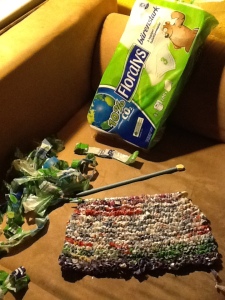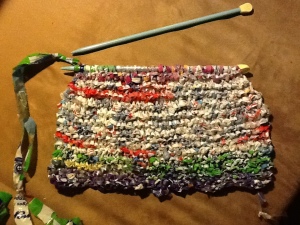
Meine Mitbewohnerin ist die wahre Upcycling Queen. Ich liebe besonders die Dinge, die einfach umzusetzen sind, aus Materialien die uns ständig umgeben, um dann in etwas praktisches und ungewöhnliches umgewandelt zu werden. Untertöpfe gibt es in unserem grünen Haus immer mal, von gekauften Kräuter, Blumen für den Balkon oder Pflanzen für den Garten. Besonders die kleinen benutzt man selten wieder. Manchmal verschenken wir Ableger darin. Eine außergewöhnlichere Idee: Einfach das untere fünftel gerade abschneiden – und ein Seifenhalter ist geboren. Love it!


Waste, no its not to waste. It can be resourceful – Just a matter of perspective.
Upcycling means to give higher value to something that has lost its purpose or meaning. It means re-using things and adding value through creativity. Instead of throwing the bags that contained my coffee beans I look for their other possible functions.



One of the things with the shortest lifespan are plastic wrappings and bags. During one of my last workshops I made various flower pots from plastic bags, drink cartons, floppy disks and washing liquid plastic bottle. For the outer layer I used a good looking bag or box, for the inner pot I used a bag or box that I filled with soil and plants. Two drainage holes are cut into the bottom. For convenience the inner pot stands on the cut off bottom of a plastic bottle like in the picture below.

The workshop table during pot production.

A beautiful plastic bag that once held rice is covering a milk carton with two drainage holes, filled with soil and plants.

And here is how to make germination pots from milk cartons.




Even better is this vertical garden using milk cartons. When using the same package it looks pretty good! Now you just need to look after the plants 

Plastic is a crazy material. In comes in various forms and is omnipresent. Once you start looking for it you see it everywhere. Packaging of food and drinks, household tools, our tooth brush, even in our cloths in the form of polyester. The exact components are often a secret by the producer. The main component however is raw oil, a scarce resource. Once turned into plastic it takes hundreds of years to decompose. Since we use it much and only shortly it is a real environmental problem. In the decomposing process micro plastic enters the food chain. It fills the stomach of animals and carries bacteria. Through meat, hot food and drinks on plastic it enters our body. Studies have shown that plastic has entered out blood stream and can lead to infertility. The documentary Plastic Planet gives a good insight on its reach.
The best way is to avoid plastic as much as possible. A simple start is buying fresh products e.g. at the market and bringing your own bag. When shopping elsewhere I try to buy products in larger packages or in paper bags or cartons. Pioneers, experimenters and fore thinkers are showing that there are many ways to reduce it with homemade beauty or cleaning products.
Another problem is it’s short lifetime. Plastic bags for example are used 25min on average. Upcycling them means adding value to them and making them usable longer. Plastic bags can be ironed together into a robust larger plastic sheet or they can be knitted, braided and crocheted with. They also make for good flower pots. Plastic bottles and milk cartons can be turned into a vertical garden. More inspiration can be found here.

Vertical gardens are great for a balcony or other small outside areas. From plastic bottles you an easily and quickly build you own – reducing waste & cost. Here is a great description with pictures on how to build your own: http://containergardening.wordpress.com/2011/09/07/bottle-tower-gardening-how-to-start-willem-van-cotthem/

The picture shows the start of two small towers as I had only a few bottles – all in different sizes. I mainly use glass and avoid plastic wherever possible. So I gathered them from my family, sat down for 10mins to read the instruction, another 10mins slicing up bottles and squeezing in dirt and strawberries and YAY to the start of my new vertical garden.
I will probably continue it whenever I come across more bottles – I am not in a rush.

Most products are wrapped in plastic. It is hard to avoid in your daily shopping from food items to toilet paper. Plastic bags are easily turned into plastic “wool” for knitting or crocheting. Start reusing plastic bags by making yarn out of them. You can then knit or crochet anything that comes to your mind. I was inspired at Peats Ridge Festival – a New Years festival near Sydney know for it’s sustainability focus. The little workshop tent was full of hand bags and clutches.
In the picture below I have started knitting a curtain for our bathroom window out of the plastic bag that toilet paper is stored in. Preparing the plastic wool is more time consuming than buying wool but it takes rather time than money and then the knitting is much faster as plastic is thicker than wool. The outcome also makes for different purpose than wool. It is more robust and can also turned into e.g. a mat for shoes. You can go colourful. You can knit hand bags and braid the handles. You might want to experiment with different size needles.
Be creative and share your ideas with me!


How to create yarn out of plastic bags:
1. stretch a plastic bag
2. roll it up like dough for cookies with the longer side facing you.
3. cut off the end parts – the bottom rim and the handle
4. cut the long dough piece in 2cm wide pieces
5. unfolded they turn into a large loop.
6. now you connect loop through looping and you will have a string of yarn
This is a great video to explain the process http://www.youtube.com/watch?v=hdTm2V4ssvY
Inspiration for a creative green life



















